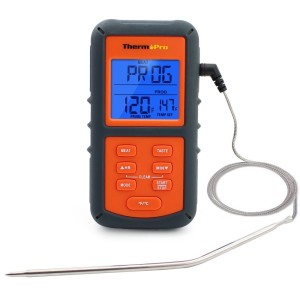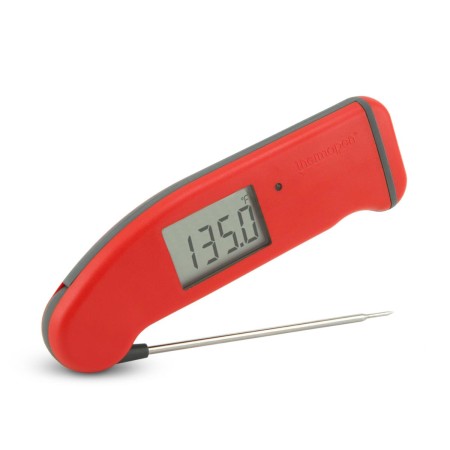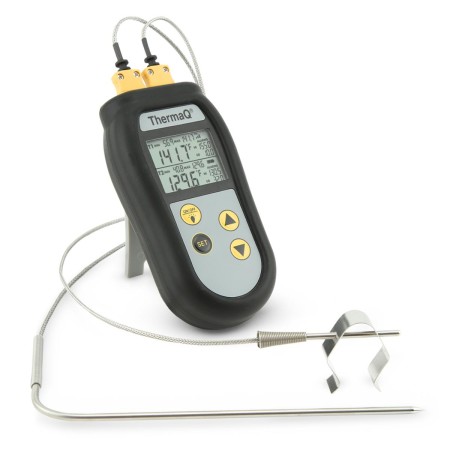A kitchen thermometer is one of those things that you need to buy first when equipping a kitchen. At first glance, it seems that there is nowhere to use it and it is only needed for beginners or insecure chefs, but this is not at all the case.
When preparing some dishes, a thermometer can help you bring them to the desired point of readiness and serve them exactly as you intended. For example, when cooking steaks, you can precisely control the degree of frying by sticking a thermometer into the meat. And when preparing caramel – you can’t do it without a thermometer at all.
But steaks and caramel are far from the only things to use for a thermometer: chicken, pork, lamb, fish, and so on. For proper preparation, all this requires temperature control and an understanding of the processes that occur inside the product. A thermometer can not only increase your culinary skills because thanks to a more accurate determination of the point of readiness, you will finally stop serving over-dried and non-chewing pieces of meat but even save someone’s life.
If you are not a reinsurer in cooking and the above about over-dried meat is not about you, then you should know the following: it is almost impossible to determine by eye or time a safe temperature for use for a particular product.
Transparent juice flowing from meat, its palpation, exact observance of the time frame – these are just methods for an approximate determination of readiness. Want to get even more confused? Do you know that in some cases and products the white color of meat does not mean that it is 100% safe and ready, just like pink – that it is not ready?
Think about it, professional chefs who spent 10 or more years at work use thermometers for cooking, although most of them are able to determine readiness with closed eyes simply by smelling (this is an exaggeration of course). They use them not because they are not confident in their abilities, but because accuracy and complete control are important to them.
And for us, amateurs, this accuracy and control are even more important. Analysis of measurements not only helps to prepare something correctly, but it also helps to navigate better in the kitchen.
By measuring the temperature and analyzing the results, an understanding of the relationships between temperature, firepower, cooking time, the thickness of a piece of meat, and other factors will gradually come to you. Understanding these dependencies and properly regulating some of them will allow you to cook better, faster, and tastier.
TYPES OF THERMOMETERS
There are two main types of thermometers: electronic and analog. Let’s look at its advantages and disadvantages.
ANALOG THERMOMETERS
The biggest disadvantage of analog thermometers is their accuracy. Although no, they are basically fine with accuracy, the problem is in the scale and its measuring range: it is either narrow, suitable strictly for certain purposes, or wide, suitable for any needs, but with a difficult to read scale – by which you can determine the temperature only approximately, with an error of a few degrees.
The advantages include the relative cheapness and that they are easy to clean. You can easily rinse them under running water without fear that the drops will fall inside, to the electronic part, which will make it unusable.
ELECTRONIC THERMOMETERS
These thermometers are more expensive than their analog counterparts, but at the same time, they have greater accuracy and many other advantages.
There are a huge number of varieties of electronic thermometers, but I will focus on 3 of them, in my opinion, the main ones.
Standard thermometer
By standard, I mean a similar analog design, when the thermometer probe is attached to the main unit, which shows the temperature.
This is the simplest, most popular, and cheapest form.

Despite the fact that this is the simplest variety, it will cover 95% of all your needs for thermometers. The only minus, in my opinion, is that you can’t stick this thermometer in the meat, put in the oven, and watch the cooking process.
Firstly, there are a lot of plastic parts in it, which simply can melt. Secondly, even with short-term exposure of a high temperature – the displays of most thermometers cease to show the information.
I use just such a thermometer from Weber (as in the photo on the left).
UPD after a few months. No longer. I discovered the ThermoWorks brand and fell in love with it. At the moment I use this one, it is more expensive but it’s worth it. Weber after a few months of use began to show frank nonsense. I don’t know why it happened, maybe it was hit somewhere, maybe something else. But even by comparing the two new devices, Thermoworks wins anyway.
Firstly, it measures faster (and the manufacturer clearly indicates how much time it needs to show the current temperature (5-6 seconds).
Secondly, according to my subjective measurements, it shows a more accurate temperature, although the allowable error for both models is approximately the same.
In the future, I want to buy their Thermapen MK4. It is one of their top models, costing $99 and determining the temperature in 2-3 seconds.
A few more thoughts on why you should not save and immediately buy a good one – read below.
Remote probe thermometers
This is basically the same standard thermometer, its only difference is the probe, which is attached to the body not tightly, but on a special cable.
The remote probe just solves the problem of controlling the readiness of the product in the oven. Whether you need it or not – decide for yourself.
Also, there are models of such thermometers with a lot of additional functions: determining the degree of readiness, timer, sound signal when a certain temperature is reached.
Not all of them need all these chips, and you can easily do without them. On the other hand, they significantly simplify life, allowing you to control the degree of preparation more accurately. As an example, I will give ThermoPro TP-06, which I’m going to buy in the near future.
Here is a partial list of what it can do:
- The display has three colors of illumination, it lights up blue when you start cooking, green when the dish is almost ready and red when it reaches the set temperature inside the meat.
- The thermometer’s functionality allows you to choose the type of meat (there is also a “fish” mode) that you are going to cook and set the desired degree of roasting. All that is needed next is just to wait for the timer signal, which will notify you a minute before the meat reaches the desired temperature. If cooking over an open fire, be sure to turn over on time.
- Suitable for oven, barbecue, grill, and smokehouse. The cable is about 1 m long. It is made of stainless steel and can easily withstand prolonged exposure to high temperatures.
UPD: all the above is relevant, I’m still looking for a similar model, but between the brands, I will definitely look towards ThermoWorks which I’ve written above.
Infrared thermometers
Their essence is that they measure the temperature at a distance.
This type of thermometer is slightly more expensive than standard thermometers and has its own characteristics and disadvantages.
The positive aspects include:
- temperature measurement from a distance up to several meters;
- The immediate reaction of the sensor – you do not need to wait 7-10 seconds until the probe heats up to a real temperature, you immediately see the result on the display;
- since the thermometer doesn’t come in contact with food, it does not need to be cleaned;
The cons:
- cost: Chinese start at $20, brand models from $50, the difference is in the error of readings;
- the farther the distance to the measured object – the higher the error;
- a thermometer is capable of measuring only surface temperature and is not suitable for determining the readiness of meat from the inside;
It is worth buying such a thermometer only if you have a clear idea of how it can be useful to you.
I bought a similar model about 2 years ago and have used it only a few times since then. Its main differences from the standard one are the ability to measure the temperature of a pan, baking sheet, or other surfaces, as well as the ability to measure the temperature without violating the integrity of the dish shall, but in most cases, this doesn’t make sense.
HOW TO CHOOSE AND WHICH THERMOMETER TO BUY?
There is only one rule here – do not buy Chinese junk from Aliexpress or from local resellers.
A $ 2-3 thermometer definitely won’t be good. Be guided by the price of $10 and, preferably, look towards well-known brands. Which ones? I wrote above about Weber and ThermoWorks. Weber – make good, almost non-killable grills, smokehouses, and other devices. And ThermoWorks specialize exclusively in thermometers. Do you know what I mean?
Of course, it may seem to you that they pay me for PR, but this is not at all the case. I recommend a good product that I was pleased with myself, just as I recommended the Weber thermometer first, which after a while disappointed me.
Below is a small list of differences between using cheap Chinese and better thermometers, based on personal experience.
- Measurement speed: a cheap thermometer needs 3-6 times more time to estimate the temperature;
- build quality: cheap thermometers are flimsy, they are very easy to break off the probe and despite the fact that it will continue to work, this fact does not turn it into a thermometer with a remote probe, because since then it shows complete rubbish;
- measurement quality: although the Chinese say an error of +/- 1 degree, in reality, it turns out to be +/- 3 or even +/- 5, it’s good when there is a calibration option, but such an option exists on more expensive models and it’s easier to buy a quality thermometer right away.
Below I have selected several models for you, which I have sorted by price and shared my opinion about each of them – choose whatever you like best and just buy. All these are high-quality good things. The links lead to the American Amazon, they do not send directly to our region, but this is not a problem, there are a huge number of intermediaries that will help you make a purchase.
You can learn more about them and their services from the article intermediaries for purchases abroad and what services they provide, but this is if you are a complete beginner and have never bought anything in foreign online stores and/or on eBay.
If you have the experience, I’ll just recommend to you my intermediary whose services I use quite often – pochtoy.com. I can attribute to their advantages: very high-quality packaging of goods, quick response of support services, pleasant rates.
Polder THM-515 ($7.77) – an analog thermometer for caramel, a temperature range of 40-200 degrees Celsius. Such a model should be chosen only if you are fond of cooking confectionery products and at the same time, you do not need a wider digital functionality.
Weber 6492 ($9.99) is my choice, I use this type of thermometer (no longer). Good quality, tillable display, quick temperature measurement. Suitable for any culinary needs. Suitable for measuring the meat temperature, liquids, and other products where it is possible to stick a probe. Do not leave in the oven / under the closed grill lid.
ThermoPro TP-06 ($24.99) – a thermometer with a remote probe, I wrote about its advantages above. Suitable for all the same needs as the previous one, but thanks to the remote probe, you can measure the temperature inside the dish located in a closed oven.
Ivation IVAWT738 ($69.99) is a real find for device lovers. The thermometer consists of two radio units: in the first one there are two remote probes, each about a meter long, the second is designed to control the temperature. The bottom line is that you can stick one or both probes into the product you are cooking and go to a distance of up to 1 kilometer and take the second block with you. It will display information about the degree of cooking for each of the probes, that is, you can cook two completely different dishes and control their readiness at a distance.
The thermometer also has 15 pre-installed programs for different types of meat/fish, and each of them can be installed on a specific probe: for example, you can stick the first in beef, which you want to fry to a medium degree, and the other in chicken, which you need to bring to full readiness and observe the temperature at the same time. In addition, based on the selected program, each of the sensors will notify you that a particular product has reached the required temperature.
UPD after a few months.
The above models, no doubt, have the right to life, including in your kitchens. I would cross out only Weber, although I still think that for the money that they ask for it, this is a good choice, as well as ThermoPro, reviews of which have recently become worse.
I supplemented the article with a recommendation to look towards the market leader in digital thermometers represented by ThermoWorks, a brand specializing exclusively in thermometers. They have a huge range of the price from $20 to $200 +. For most models, they give a 2-year warranty.
If you want to buy an excellent thermometer and plan to use it often, I wouldn’t recommend saving money, but immediately looking in the direction of this brand. I think they won’t disappoint you.
In our region, buying their products is problematic, you need to order from the official website from the USA.
And here is, what I would recommend paying attention to from the ThermoWorks lineup:


Super-Fast® Pocket Thermometer ($24). My new assistant. Temperature measurement in 5-6 seconds, thin probe, good design. The temperature is shown both in Celsius and in Fahrenheit, there are Min / Max functions. The manufacturer claims 5,000 hours of battery life.
Thermapen® Mk4 ($99) The top model of a standard thermometer that measures
temperature in 2-3 seconds. It is considered the fastest thermometer released to the mass market. A favorite of many professional chefs around the world.
ThermaQ® 2 Channel Thermocouple Alarm ($139) – a thermometer with a remote probe, has two independent channels. Please note that this is only a meter; the probes are purchased separately.
